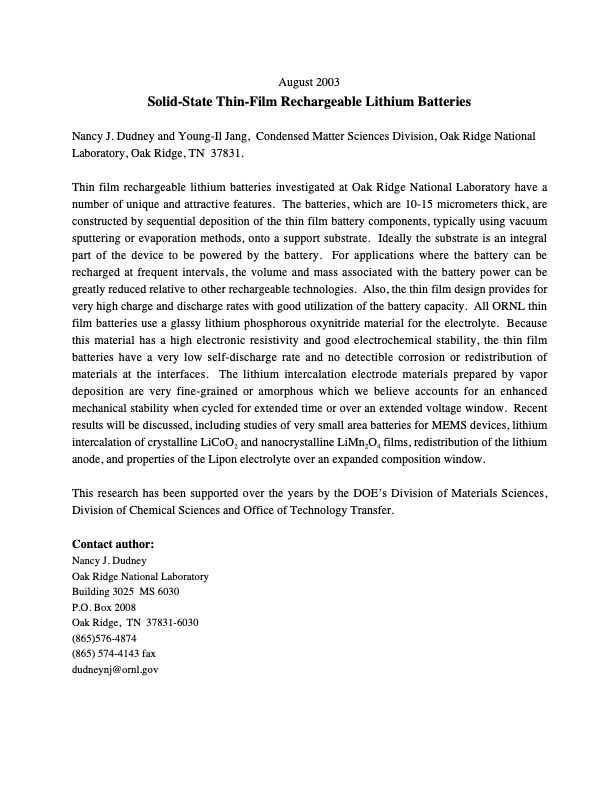
PDF Publication Title:
Text from PDF Page: 002
August 2003 Solid-State Thin-Film Rechargeable Lithium Batteries Nancy J. Dudney and Young-Il Jang, Condensed Matter Sciences Division, Oak Ridge National Laboratory, Oak Ridge, TN 37831. Thin film rechargeable lithium batteries investigated at Oak Ridge National Laboratory have a number of unique and attractive features. The batteries, which are 10-15 micrometers thick, are constructed by sequential deposition of the thin film battery components, typically using vacuum sputtering or evaporation methods, onto a support substrate. Ideally the substrate is an integral part of the device to be powered by the battery. For applications where the battery can be recharged at frequent intervals, the volume and mass associated with the battery power can be greatly reduced relative to other rechargeable technologies. Also, the thin film design provides for very high charge and discharge rates with good utilization of the battery capacity. All ORNL thin film batteries use a glassy lithium phosphorous oxynitride material for the electrolyte. Because this material has a high electronic resistivity and good electrochemical stability, the thin film batteries have a very low self-discharge rate and no detectible corrosion or redistribution of materials at the interfaces. The lithium intercalation electrode materials prepared by vapor deposition are very fine-grained or amorphous which we believe accounts for an enhanced mechanical stability when cycled for extended time or over an extended voltage window. Recent results will be discussed, including studies of very small area batteries for MEMS devices, lithium intercalation of crystalline LiCoO2 and nanocrystalline LiMn2O4 films, redistribution of the lithium anode, and properties of the Lipon electrolyte over an expanded composition window. This research has been supported over the years by the DOE’s Division of Materials Sciences, Division of Chemical Sciences and Office of Technology Transfer. Contact author: Nancy J. Dudney Oak Ridge National Laboratory Building 3025 MS 6030 P.O. Box 2008 Oak Ridge, TN 37831-6030 (865)576-4874 (865) 574-4143 fax dudneynj@ornl.govPDF Image | Solid-State Thin-Film Rechargeable Lithium Batteries

PDF Search Title:
Solid-State Thin-Film Rechargeable Lithium BatteriesOriginal File Name Searched:
118282.pdfDIY PDF Search: Google It | Yahoo | Bing
Sulfur Deposition on Carbon Nanofibers using Supercritical CO2 Sulfur Deposition on Carbon Nanofibers using Supercritical CO2. Gamma sulfur also known as mother of pearl sulfur and nacreous sulfur... More Info
CO2 Organic Rankine Cycle Experimenter Platform The supercritical CO2 phase change system is both a heat pump and organic rankine cycle which can be used for those purposes and as a supercritical extractor for advanced subcritical and supercritical extraction technology. Uses include producing nanoparticles, precious metal CO2 extraction, lithium battery recycling, and other applications... More Info
| CONTACT TEL: 608-238-6001 Email: greg@infinityturbine.com | RSS | AMP |